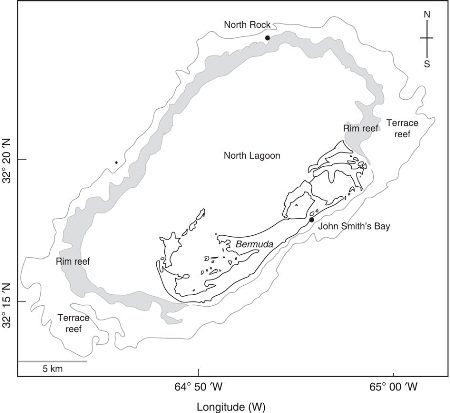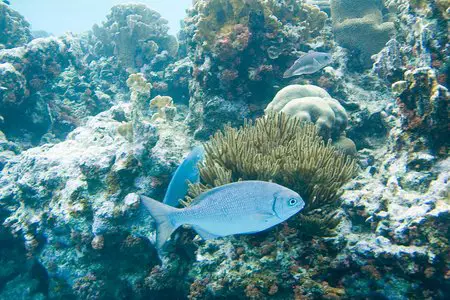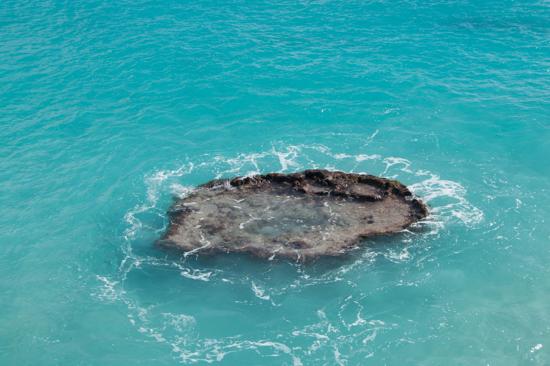Amazing Coral Reefs of Bermuda
One of the greatest attractions for divers and snorkelers in Bermuda are the wide range of beautiful and colorful corals and coral reefs that can be seen in the Atlantic surrounding the island. You may sometimes confuse some corals as plants... they are not plants.
Corals are marine invertebrates, a form of animals. Some of them can feed on plankton (small marine organisms), small fish, while most feed on algae.
Bermuda's coral reefs are some of the northern most reefs in the North Atlantic and many of them are quite large in size. Corals require warm water temperature to the range of 76-85░F to survive. Fortunately the nearby Gulf Stream keeps the water around Bermuda warm and clean.
This is the main reason why corals in the North Atlantic waters around Bermuda continue to thrive. The coral reefs here have remained quite healthy despite the fact that in winter, the water temperature falls below the level what corals ideally need.
Note that the living corals form only the thin upper layer of the reefs. Below them are all dead corals. A single coral may be quite tiny, whereas a coral head or a colony of corals consists of numerous coral individuals who stick together and look like a massive entity. But the living corals on the surface of the rocks are quite delicate and can get easily damaged by contact.
How these massive underwater coral reefs have been formed in Bermuda? Actually the corals secrete a chemical called Calcium Carbonate, which then takes the form of limestone. Over time when millions of such corals keep adding to the limestone rocks, it forms a shape and size of a massive coral reef. But the process takes many years.
Types of Coral Reefs in Bermuda
There are three different types of Coral Reefs that are lying around the island of Bermuda. As you can see in the diagram below, they are located in three different reef zones: Lagoon reefs (also known as North Lagoon Reefs), Rim Reef and the Terrace Reef. Most outer reefs are seen towards the northern water areas of Bermuda and some off the southern shore as well.
Lagoon Reefs
As the name suggests, the Lagoon Reefs are formed in a lagoon water area that surround the immediate vicinity of Bermuda and also that form the inshore water areas. The water here is relatively calm and waves are low. However due to low wave actions, lot of silt or sedimentation takes place in this water area. The Lagoon Reefs have depths ranging from 10 to 20 meters.
You will mostly find Soft Corals in Lagoon Reef area which are able to withstand the low wave actions and also get rid of the sedimentation from their surface. Due to the silt, the bottom of the ocean floor here is sandy. The Lagoon Reefs have relatively lower visibility due to continuous sedimentation which blur the water area surrounding them.
Corals in the Lagoon Reef area includes soft corals like the Sea Rods, Sea Fans, and also branching corals like Madracis, Oculina etc. You can often mistake Sea Rods as plants as they do not have hard skeleton like bodies and rather soft rod like structures that sway in the wave current.
Since the polyps of these rods are often open during the day time, they also look bushy. Their colors can be blue, tan etc. Sea Fans look like hand fans embedded on the reefs. On the other hand the branching corals like Madracis have club like rod structures with small polyps. They often grow on the vertical surface of the reefs rather than on the top.
Bermuda Coral Reefs
Photo: Paul Asman and Jill Lenoble, flickr, cc by 2.0
Rim Reefs
They are so called because they form a rim around the boundary of the lagoon water area. They have an average depth of 2 to 10 meters. These reefs are massive in size and usually comprises of hard corals like the Brain Corals and the Star Corals. Rim reefs have great visibility.
As the name suggests, the brain corals look like the surface of human brain and the star corals have appearance like stars. The largest reef of Bermuda - The
North Rock is part of the Rim Reefs. You will also find plenty of sea fans and sea rods in the rim reef area.
Boiler Reefs which are also part of the Rim Reef system can be found at the Southern and South Eastern water areas of Bermuda.
A boiler reef close to Horseshoe Bay Beach
They have round heads and reach up to the surface of the water. As the waves continuously break on the surface of the reef, the water area here looks like as if boiling (i.e. churning), and hence such name for the reef. Curlew Boiler is one such reef which lies at the eastern edge of island's reef line. It's so named because a ship named Curlew sank here in 1856.
Terrace Reef
This is the outermost reef system and comprises mainly of hard corals like Brain and Star corals. The visibility of the reefs are excellent.
Coral Reefs have been a great boon for the island. First they act as a barrier and protect the island against heavy wave actions and currents. The reefs are also biological hot spots being habitat of many different marine creatures and fish, many of which have great commercial value.
In fact
a study reveals that Bermuda's reef system is worth close to one billion dollar. The Government of Bermuda has passed laws since the 1600s and subsequently to protect the coral reefs. There are now 29 protected marine areas which have now become some of the greatest dive sites in the world.
But Bermuda's coral reefs had also created serious navigational hazards for early mariners. Over 300 ships were wrecked due to these reefs that lye within 200 square miles water area surrounding the island of Bermuda.
Update December 2014: Bermuda Zoological Society has recently come out with their report on the reef health survey which was conducted in June this year. According to the report, the coral reefs and the plant eating fish in Bermuda waters continue to be healthy. Over 20 teams surveyed around 40 patches of reefs at the North Lagoon area. They used hula-hoops to find coral health, amount of sea weeds on corals and the fish and marine life. But one concern was 80% of the reefs have very low to almost no predatory fish which are required for health of the corals.
Why predatory fish required for corals? Note that although Damselfish coexist with the corals, they can spread algae which in turn can kill the corals. Therefore it is important that predatory fish like the groupers, snappers also exist at the reef area which can prey on damselfish and eliminate them. Similarly Parrotfish, doctor fish and chubs help by eating the plants that try to take up space where corals could grow.
Popular Coral Reefs of Bermuda
Here are some great coral reefs in Bermuda waters - how they look, where they are located, how to reach the reef site, fish andámarine life that you can see there and more.
This is the largest coral reef in Bermuda and now a protected nature preserve. The shallow reefs of the North Rock Nature Preserve cover an area of 1000-meter radial distance from the North Rock Navigational Beacon.
Itĺs like swimming in an aquarium. The coral reefs here have formed beautiful arches under the water and you can swim through them.
This coral reef is located at the end of Eastern Blue Cut, where the shallow waters meet the North Atlantic. This is a classic multi-level site, with a maximum depth of 55 feet.
This is a series of shallow blind breakers. Many ships heading towards the navigational guiding light at North Rock, met their ill fate on these shallow, blind breaker reefs.
With an average depth of only 28feet and typical visibility in excess of 100feet, South West Breaker provides an excellent shallow dive for both novice and experienced divers. The shallow depth and the variety of fishes make it a great place for snorkeling as well.
This is another popular reef site where you can see the rare queen conch.
Both Basilica and the Cathedral reefs are located quite close to the opening of Castle Harbor, Bermuda's original port entrance. Depths vary from the shallows of 15 feet to around 55 feet.
Go through this section to know about several other great reef sites that are popular amongst divers. Also know about their location, formations, marine life and lot more.
|
 By Raj Bhattacharya By Raj Bhattacharya
Raj, a seasoned travel writer and Bermuda destination expert, has extensive global travel experience. This website reflects his profound insights, garnered over nearly two decades of dedicated findings and research on the island. Raj has assisted countless Bermuda-bound visitors by providing direct, personalized responses to their queries and imparting his wealth of knowledge through this platform. This site serves as an indispensable guide for those seeking informed and reliable insights into Bermuda's treasures.
|
Related Articles
|
Visitors' Reviews andáComments
Review and share your experience.
|



 By Raj Bhattacharya
By Raj Bhattacharya